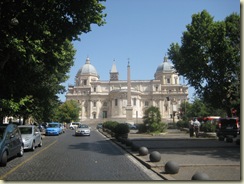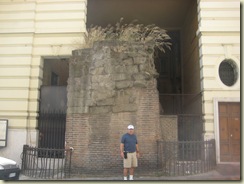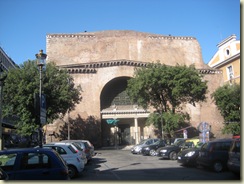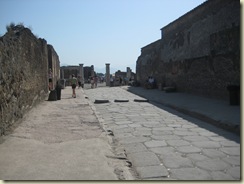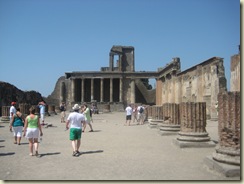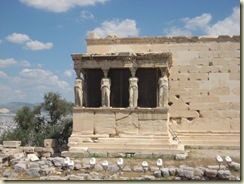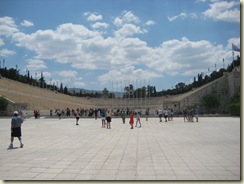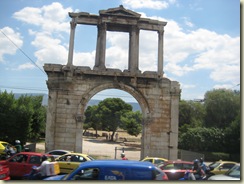Friday, July 17, 2009 – Rome Italy, 87F – Sunny
They actually remembered us at the Best Western Villa Franca hotel (we had stayed there pre-cruise). This room was almost the same as the one we had pre-cruise with one exception: The shower – glassed in on all sides - was too small for anyone over 5 ft tall. I felt like one of those mimes trying to get out of the glass enclosure – we did eventually switch to a room with a human sized shower (and a tub for Ellen as a bonus).
Even though we just completed an 11 day cruise and a lot of walking up hills, we were eager to see more of the sites of Rome on foot. The only issue was the heat but there was always shade to be found. We explored an area behind the Roma Termini Station looking for souvenirs. It seems that we always wind up walking through the Termini Station – except for the incredible cigarette smoke density, the place is a people watcher’s paradise. There are people with “wheelies” everywhere and from everywhere.
Ellen went back to the Hotel and I did a little more sightseeing. One spectacular structure was the Santa Maria Maggiori Cathedral complete with ornate obelisk.
Santa Maria Maggiori Cathedral from Piazza Esquilino
Santa Maria Maggiori is a fifth century major (papal) basilica. The current structure is the product of several restorations over the centuries.
A curious site near the adjacent Piazza Esquilino was a mini-gas station.
The station is located in a little turnout in the street. It reminds me of the letter drops at the post office but in this case, you can fill up your motor scooter or car. I hope the gas caps are all on the correct side for the cars in Rome.
On the way back to the Hotel, there is a street that must contain fifty or more motor scooters or “bikes” as one of the locals called them. We had seen these bikes locked and parked there many times as we walked to the Termini Station. For some reason, somebody or something had set about six of these bikes on fire and all that was left of them were burned out hulks. All the other bikes were left untouched. They were all still there – a kind of art, actually, when we left the city.
Torched “bikes” near Termini
We decided to have a real Italian Meal at one of the local restaurants. One of them (and there are restaurants literally every 50 yards) advertised no cover and no “service” (tip) plus a 10% discount – an offer we couldn’t refuse. There was no one at the restaurant and plenty of people at the place next door. The waiter explained that this was not a reflection of the quality of the restaurant and that the neighbor was a bar that was open all the time – restaurants do not see many patrons this early in the afternoon. We shared a Pizza Margherita and I had a salad – a small meal compared to other diners. The pizza was not nearly the quality of our Neapolitan pizza but we did eat Al Fresco. FYI: Ice in your water is not available in Rome (so far as we know).
Saturday, July 18, 2009 – Rome Italy, 87F – Sunny
This day is planned as a major walking day (not realizing what was in store for us on Sunday – you’ll see what I mean in an upcoming post). There are many historical and archeological sites within walking distance of our hotel and we actually have a plan to see as many as we can.
Our first stop is the Porta Pia, a gate on the Aurelian Wall, which enclosed all seven hills of ancient Rome. It was originally designed by Michelangelo but completed using a different design. It is named after Pope Pius IV and was completed in 1565. A war memorial stands in the square opposite the Porta Pia.
The Porta Pia and War Memorial
The Aurelian Wall (no doubt repaired and restored) is still visible as you walk through the area.
Aurelian Wall
As part of this walking tour we were looking for a residential neighborhood – all we had seen so far was the pizza-hotel layout, which dominated the area where we were staying. We reached a tree lined boulevard – Via Margherita – that was mostly shops and apartments. Just what we were looking for.
A few blocks into this street, we noticed what appeared to be a fenced in park. Peering through the bars, we discovered some ruins as well an old villa.
A once noble villa on Via Margherita
There was an Italian gentleman nearby and we asked him about this park – his English was good enough to relate the fact that this home was owned by one of the noblemen of Rome during the 16th Century. The park and the home were not open to the public. It seems a waste of history.
The man also gave us directions to a nearby neighborhood where we would find some amazing architecture – not old but neo-old. He was certainly correct – one example of the kind of homes we found was an apartment building with an external chandelier.
Building with Chandelier in the Archway
Back to the hotel for lunch and a little rest – when it got a little cooler outside (late afternoon), we were back on the road.
Our new goal was the Via Veneto – if you know why that’s an important site in Rome, give yourself a trivia point (I’ll explain later). As we made our way there, we came across what must be a relatively common occurrence in a historical city like Rome.
A new building – an old building – and me
I’m referring to the building of new structures around archeological finds. It gives the building an automatic museum feel to it because the ancient find is noted and explained.
We also found additional sections of the ancient wall but at one location, we noted a very common (but interesting) addition– a drinking fountain in the old wall.
No, we were still not brave enough to take a drink – it’s a long flight home and I don’t want to make that trip in the baggage compartment.
We finally arrived at our target destination – the Via Veneto – an upscale street with very nice (and pricey stores and restaurants). What is this street famous for?
Ellen and the La Dolce Vita Restaurant
The 1960 Fellini classic - “La Dolce Vita” – was filmed on and around this street. There is a restaurant that claims to be the one in the movie. It is a fabulous street and worthy of Marcello Mastroianni and Anita Ekberg. After walking up and down the entire street, we headed to our next site – the Palazzo Margherita, a vast structure on the Via Veneto, and built in the 19th Century.
Today, it is home to the US Embassy – we know where to place our embassies. Although I am sure this is a very secure building, we didn’t see any security personnel (armed soldiers) of the type we saw guarding the Turkish Embassy.
Heading home, we passed the Planetario (Planetarium)
The Planetario
and then another view of the Santa Maria Degli Angeli Basilica located on the Piazza Della Repubblica.
Santa Maria Degli Angeli Basilica
The church was designed by Michelangelo but the final design was not his. It is now a parish church.
Termini Station is nearby which means we are nearly home.
Later in the evening, we decided to try one of the “pizza by the gram” restaurants. The price of your pizza depends on the weight of the slice. Many of the pizzas sit there for a while until someone wants a slice; then they are heated in a pizza oven – no nuking here. These places are very popular since it probably takes less time to get your food. Not thrilled by the stuff available, we did try a couple of slices of a pizza that just came out of the oven. Not bad but not Naples.
This day is a wrap.

